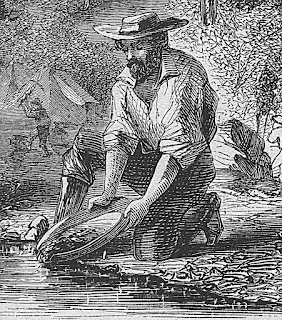When most people think of gold mining during the California Gold Rush, they have in mind placer mining. Placer gold is surface gold found in sand or gravel in rivers and creeks.
In
the early days of a gold strike when surface gold was readily available in gravel
of stream beds, panning was the method of choice. This iconic picture shows a
miner with a pan mining for gold.
Early miners, especially, if they could not
find a gold pan, used tightly-woven Indian baskets.
Panning for gold was the first method used in the California gold fields because it was inexpensive, fairly simple, and could be done by one person. This method used water to separate particles of gold from sand, gravel, and clay. A miner would shovel dirt into a pan, then swirl the pan under the water, until the gravel, clay, and most of the dirt was washed away. Since gold is heavier than these other substances, any gold in the original sample would remain in the pan. While this work was a simple and inexpensive method, it turned out to be extremely physically demanding. Miners had to work for hours in the sun, squatting near a stream, carefully performing precise movements so no gold would be lost.
Improvements were soon made to the process of panning for gold. First, the rocker was developed, an oblong box mounted on rockers and higher at one end.
Groups of three men usually worked together to pass dirt through a sieve, collecting the gold and gold dust that remained trapped behind the cleats nailed to the bottom.
 |
| Rocker box-Columbia State Park Museum, California |
Another variation was the sluice box, with cleats. The sluice box is a tool used in gold mining in which, a long trough style box with riffle bars or raised blocks on the bottom of the trough, trap pieces of gold as water, sand, and gravel wash through the box.
 |
| Rocker box with cleats-Columbia State Park Museum, California |
These
miners are shown standing among several sluice boxes.
This method was easier than panning, as men could exchange jobs. Also, they were able to process much more dirt in a day, thus increasing the amount of gold found.
Since a rocker or cradle required at least three men, it was necessary for miners to find people with whom they were willing to share.
The long tom was an improvement on the rocker, and usually required 6 to 8 men. This was the start of developments that would move mining away from individual miners, and into the control of large corporations.
In
the period of the California Gold Rush itself (roughly 1848-1853), perhaps
10-12 million ounces of gold were produced (worth many billions of
dollars at today's prices). This was the era when individuals could hope
to strike it rich.
Quite
a few lucky miners did, but most barely made enough to live on. Eventually,
many of the men drifted to other areas promising a boom, to other types of
gold production, or other types businesses.
Sources:
Hayes,
Garry, “Mining History and Geology of the California Gold Rush,” http://hayesg.faculty.mjc.edu/Gold_Rush.html
Columbia State Park Museum, Columbia, California
http://picturethis.museumca.org/timeline/gold-rush-1848-1860/mining-techniques/info
Zina Abbott is the pen name used by Robyn
Echols for her historical novels. Her first three novellas in
the Eastern
Sierra Brides 1884 series, Big Meadows Valentine, A
Resurrected Heart,
and Her Independent Spirit were published by Prairie Rose Publications. Her novelette, He Is
a Good Man, was published in the Lariats, Letters and Lace anthology.







Zina,
ReplyDeleteI always enjoy your articles about gold mining, and I learn something [or somethings :-)] new every time. This one reminded me of the song in 'Paint Your Wagon' about gold fever.
Thank you, Kaye. There was plenty of gold fever when it came to the California Gold Rush. Unfortunately, by the time many of the American gold seekers arrived in the early 1850's, the easy placer gold had been found.
ReplyDeleteIt was hard work for sure. Oh the dreams of the folk who followed the lure of 'easy' money. Looks like no matter how you look at it, you still had to work for it. It was the rare person who managed to come out ahead.
ReplyDeleteThank you for adding to the knowledge of this exciting and demanding era. Doris
They certainly had some interesting methods of finding gold. What a lot of hard work. I imagine finding gold was as exciting as winning the lottery--and about as frequent. You posted some fascinating pictures, too.
ReplyDeleteGet rich schemes rarely come to fruition. Maybe they would have been better off planting a garden and doing some hunting and fishing. Crazy the things humans decide to do. But hey, it moved people westward.
Good things to your corner Robyn.